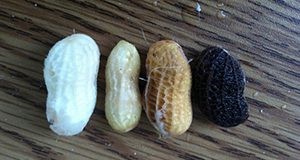Abstract
Determining when to dig is one of the most important economic decisions a grower must make. Peanut (Arachis hypogaea L.) poses a unique challenge for maturity determination because it is an indeterminate crop that forms pods underground. This 8-page fact sheet discusses maturity assessment methods as well as steps for collecting and evaluating a maturity sample. Written by Ethan Carter, Patrick Troy, Diane Rowland, Barry Tillman, Keith Wynn, Krystel Pierre, and Michael Mulvaney, and published by the UF Agronomy Department, September 2016.
SS-AGR-408/AG411: Methods to Evaluate Peanut Maturity for Optimal Seed Quality and Yield (ufl.edu)
References
Colvin, B. C., D. L. Rowland, J. A. Ferrell, and W. H. Faircloth. 2014. "Development of digital analysis system to evaluate peanut maturity." Peanut Science 41: 8-16. https://doi.org/10.3146/PS13-9.1
Ketring, D. L., and T. G. Wheless. 1989. "Thermal time requirements for phenological development of peanut." Agronomy Journal 81: 910-917. https://doi.org/10.2134/agronj1989.00021962008100060013x
Miller, O., and E. Burns. 1971. "Internal color of Spanish peanut hulls as an index of kernel maturity." Journal of Food Science 36: 669-670 https://doi.org/10.1111/j.1365-2621.1971.tb15157.x
Rowland, D. L., R. B. Sorensen, C. L. Butts, and W. H. Faircloth. 2006. "Determination of maturity and degree day indices and their success in predicting peanut maturity." Peanut Science 33: 125-136. https://doi.org/10.3146/0095-3679(2006)33[125:DOMADD]2.0.CO;2
Sanders, T. H., J. A. Lansden, R. L. Greene, J. S. Drexler, and E. J. Williams. 1982. "Oil characteristics of peanut fruit separated by a nondestructive maturity classification method." Peanut Science 9: 20-23. https://doi.org/10.3146/i0095-3679-9-1-6
Sanders, T. H., E. J. Williams, A. M. Schubert, and H. E. Pattee. 1980. "Peanut maturity method evaluations. I. Southeast." Peanut Science 7: 78-82. https://doi.org/10.3146/i0095-3679-7-2-5
USDA. 2015. "2015 Guidelines for peanut marketing activity." Farm Service Agency. Accessed on January 15, 2016. http://www.fsa.usda.gov/Assets/USDA-FSA-Public/usdafiles/Price-Support/pdf/2015/2015peanut_marketing_activity.pdf
Williams, E. J. 2003. "A simple, quick, inexpensive peanut blaster." University of Georgia. Accessed on January 15, 2016. http://athenaeum.libs.uga.edu/xmlui/bitstream/handle/10724/33345/A%20Blaster%20Bulletin.pdf?sequence=1
Williams, E. J., and J. S. Drexler. 1981. "A non-destructive method for determining peanut pod maturity." Peanut Science 8: 134-141. https://doi.org/10.3146/i0095-3679-8-2-15
Wright, D. L., B. Tillman, J. Marois, J. A. Ferrell, and N. DuFault. 2000. Management and Cultural Practices for Peanuts. AA258. Gainesville: University of Florida Institute of Food and Agricultural Sciences. http://edis.ifas.ufl.edu/aa258

